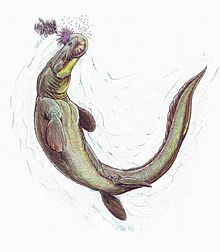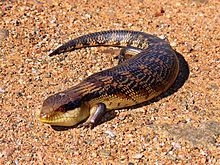- Lizard
-
For other uses, see Lizard (disambiguation).
Lizards
Temporal range: Late Triassic – Recent, 220–0 Ma
Central bearded dragon, Pogona vitticeps Scientific classification Kingdom: Animalia Phylum: Chordata Superclass: Tetrapoda Class: Reptilia Subclass: Diapsida Order: Squamata Suborder: Lacertilia*
Günther, 1867Families Many, see text.

Range of the Lizards, all species Lizards are a widespread group of squamate reptiles, with nearly 3800 species,[1] ranging across all continents except Antarctica as well as most oceanic island chains. The group, traditionally recognized as the suborder Lacertilia, is defined as all extant members of the Lepidosauria (reptiles with overlapping scales), which are neither sphenodonts (i.e., tuatara) nor snakes – they form an evolutionary grade.[2] While the snakes are recognized as falling phylogenetically within the Toxicofera clade from which they evolved, the Sphenodonts are the sister group to the Squamates, the larger monophyletic group, which includes both the lizards and the snakes.
Lizards typically have limbs and external ears, while snakes lack both these characteristics. However, because they are defined negatively as excluding snakes, lizards have no unique distinguishing characteristic as a group. Lizards and snakes share a movable quadrate bone, distinguishing them from the sphenodonts, which have a more primitive and solid diapsid skull. Many lizards can detach their tails to escape from predators, an act called autotomy, but this ability is not shared by all lizards. Vision, including color vision, is particularly well developed in most lizards, and most communicate with body language or bright colors on their bodies as well as with pheromones.
The adult length of species within the suborder ranges from a few cm for some chameleons and geckos to nearly 3 m (9.8 ft) in the case of the largest living varanid lizard, the Komodo Dragon. Some extinct varanids reached great size. The extinct aquatic mosasaurs reached 17 m (56 ft), and the giant monitor Megalania prisca is estimated to have reached perhaps 7 m (23 ft).
Contents
Physiology
 Feral Jackson's Chameleon from a population introduced to Hawaii in the 1970s
Feral Jackson's Chameleon from a population introduced to Hawaii in the 1970s
Sight is very important for most lizards, both for locating prey and for communication, and, as such, many lizards have highly acute color vision. Most lizards rely heavily on body language, using specific postures, gestures, and movements to define territory, resolve disputes, and entice mates. Some species of lizard also utilize bright colors, such as the iridescent patches on the belly of Sceloporus. These colors would be highly visible to predators, so are often hidden on the underside or between scales and only revealed when necessary.
The particular innovation in this respect is the dewlap, a brightly colored patch of skin on the throat, usually hidden between scales. When a display is needed, the lizards erect the hyoid bone of their throat, resulting in a large vertical flap of brightly colored skin beneath the head which can be then used for communication. Anoles are particularly famous for this display, with each species having specific colors, including patterns only visible under ultraviolet (UV) light, as many lizards can see UV light.
Evolution and relationships
 Fossil mosasaur Prognathodon, a varanoid
Fossil mosasaur Prognathodon, a varanoid
The retention of the basic 'reptilian' amniote body form by lizards makes it tempting to assume any similar animal, alive or extinct, is also a lizard. However, this is not the case, and lizards as squamates are part of a well-defined group.
The earliest amniotes were superficially lizard-like, but had solid, box-like skulls, with openings only for eyes, nostrils, termed the anapsid condition. Turtles retain this skull form. Early anapsids later gave rise to two new groups with additional holes in the skull to make room for and anchor larger jaw muscles. The Synapsids, with a single fenestra, gave rise to the superficially lizard-like Pelycosaurs, which include Dimetrodon and the Therapsids, including the Cynodonts, from which the modern mammals would evolve.
The modern Tuatara retains the basic Lepidosaur skull, distinguishing it from true lizards in spite of superficial similarities. Squamates, including snakes and all true lizards, further lightened the skull by eliminating the lower margin of the lower skull opening.
The earliest known fossil remains of a lizard belong to the iguanian species Tikiguania estesi from the Tiki Formation of India, which dates to the Carnian stage of the Triassic period, about 220 million years ago.[3] However, mitochondrial phylogenetics suggests that the first lizards evolved in the late Permian. Most evolutionary relationships within the squamates are not yet completely worked out, with the relationship of snakes to other groups being most problematic. From morphological data, Iguanid lizards have been thought to have diverged from other squamates very early, but recent molecular phylogenies, both from mitochondrial and nuclear DNA, do not support this early divergence.[4] Because snakes have a faster molecular clock than other squamates,[4] and there are few early snake and snake ancestor fossils,[5] it is difficult to resolve the relationship between snakes and other squamate groups.
Lizard diversification
Within the Lacertilia are found four generally recognized suborders, Iguania, Gekkota, Amphisbaenia and Autarchoglossa, with the "blind skinks" in the family Dibamidae having an uncertain position. While traditionally excluded from the lizards, the snakes are usually classified as a clade with a similar subordinal rank.[6]
Iguania
 Anoles mating, Gainesville, FL
Anoles mating, Gainesville, FL
The suborder Iguania, found in Africa, south Asia, Australia, the New World, and with iguanas colonizing the islands of the west Pacific, form the sister group to the remainder of the squamata. They are largely arboreal, and have primitively fleshy, non-prehensile tongues, some even have scales, but this condition is obviously highly modified in the chameleons. This clade includes the following families:
- Family Agamidae – Agamid lizards, Old World arboreal lizards
- Family Chamaeleonidae – Chameleons
- Family Corytophanidae – Helmet lizards
- Family Crotaphytidae – Collared lizards, leopard lizards
- Family Hoplocercidae – Dwarf and spiny tail iguanas
- Family Iguanidae – American arboreal lizards, chuckwallas, iguanas, iguanids
- Family Opluridae – Malagasy iguanas
- Family Phrynosomatidae – North American spiny lizards
- Family Polychrotidae – Anoles and kin
- Family Tropiduridae – Tropidurid lizards
Gekkota
Active hunters, the Gekkota includes three families comprising the distinctive cosmopolitan geckos and the legless flap-footed lizards of Australia and New Zealand. Like snakes, the flap-footed lizards and most geckos lack eyelids. Unlike snakes, they use their tongues to clean their often highly developed eyes. While gecko feet have unique surfaces that allow them to cling to glass and run on ceilings, the flapfoot has lost its limbs. The three families of this suborder are:
- Family Eublepharidae – 'Eyelid' geckos
- Family Gekkonidae – Geckos
- Family Pygopodidae – Flap-footed lizards
Relationship with humans
 Green iguanas (Iguana iguana), are popular exotic pets
Green iguanas (Iguana iguana), are popular exotic pets
Most lizard species are harmless to humans. Only the largest lizard species, the Komodo dragon, which reaches 3.3 m (11 feet) in length and weighs up to 166 kg (365 pounds), has been known to stalk, attack, and, on occasion, kill humans. An eight-year-old Indonesian boy died from blood loss after an attack in 2007.[7] The venom of the Gila monster and beaded lizard is not usually deadly but they can inflict extremely painful bites due to powerful jaws.
Numerous species of lizard are kept as pets.
Lizard symbolism plays important though rarely predominant roles in some cultures (e.g., Tarrotarro in Australian Aboriginal mythology). The Moche people of ancient Peru worshipped animals and often depicted lizards in their art.[8] According to a popular legend in Maharashtra, a Common Indian Monitor, with ropes attached, was used to scale the walls of the Sinhagad fort in the Battle of Sinhagad.[9]
Green Iguanas are eaten in Central America and Uromastyx in Africa. In North Africa, Uromastyx are considered dhaab or 'fish of the desert' and eaten by nomadic tribes.[10]
Classification
 Close-up of the head of the legless fossorial amphisbaenid Rhineura
Close-up of the head of the legless fossorial amphisbaenid Rhineura
 Underside of a Thorny devil, an agamid, Western Australia
Underside of a Thorny devil, an agamid, Western Australia
 The Eastern blue-tongued lizard, a scincomorph
The Eastern blue-tongued lizard, a scincomorph
Suborder Lacertilia (Sauria) – (Lizards)
- Family †Bavarisauridae
- Family †Eichstaettisauridae
- Infraorder Iguania
- Family †Arretosauridae
- Family †Euposauridae
- Family Corytophanidae (casquehead lizards)
- Family Iguanidae (iguanas and spinytail iguanas)
- Family Phrynosomatidae (earless, spiny, tree, side-blotched and horned lizards)
- Family Polychrotidae (anoles)
- Family Leiosauridae (see Polychrotinae)
- Family Tropiduridae (neotropical ground lizards)
- Family Liolaemidae (see Tropidurinae)
- Family Leiocephalidae (see Tropidurinae)
- Family Crotaphytidae (collared and leopard lizards)
- Family Opluridae (Madagascar iguanids)
- Family Hoplocercidae (wood lizards, clubtails)
- Family †Priscagamidae
- Family †Isodontosauridae
- Family Agamidae (agamas)
- Family Chamaeleonidae (chameleons)
- Infraorder Gekkota
- Family Gekkonidae (geckos)
- Family Pygopodidae (legless lizards)
- Family Dibamidae (blind lizards)
- Infraorder Scincomorpha
- Family †Paramacellodidae
- Family †Slavoiidae
- Family Scincidae (skinks)
- Family Cordylidae (spinytail lizards)
- Family Gerrhosauridae (plated lizards)
- Family Xantusiidae (night lizards)
- Family Lacertidae (wall lizards or true lizards)
- Family †Mongolochamopidae
- Family †Adamisauridae
- Family Teiidae (tegus and whiptails)
- Family Gymnophthalmidae (spectacled lizards)
- Infraorder Diploglossa
- Family Anguidae (glass lizards)
- Family Anniellidae (American legless lizards)
- Family Xenosauridae (knob-scaled lizards)
- Infraorder Platynota (Varanoidea)
- Family Varanidae (monitor lizards)
- Family Lanthanotidae (earless monitor lizards)
- Family Helodermatidae (gila monsters & beaded lizards)
- Family †Mosasauridae (marine lizards)
References
- ^ Lizards at eduscape.com. Eduscapes.com. Retrieved on 2011-11-07.
- ^ Gibbons, J. Whitfield; Gibbons, Whit (1983). Their Blood Runs Cold: Adventures With Reptiles and Amphibians. Alabama: University of Alabama Press. p. 164. ISBN 978-0817301354.
- ^ Datta, P.M. and Ray, S. (2006). "Earliest lizard from the Late Triassic (Carnian) of India". Journal of Vertebrate Paleontology 26 (4): 795–800. doi:10.1671/0272-4634(2006)26[795:ELFTLT]2.0.CO;2.
- ^ a b Kumazawa, Yoshinori (2007). "Mitochondrial genomes from major lizard families suggest their phylogenetic relationships and ancient radiations". Gene 388 (1–2): 19–26. doi:10.1016/j.gene.2006.09.026. PMID 17118581.
- ^ "Lizards & Snakes Alive!". American Museum of Natural History. http://www.amnh.org/exhibitions/lizards/snakes/world.php. Retrieved 2007-12-25.
- ^ Squamata Oppel, 1811. the Integrated Taxonomic Information System. ITIS.org
- ^ Komodo dragon kills boy in Indonesia – World news – Asia-Pacific – msnbc.com. MSNBC. Retrieved on 2011-11-07.
- ^ Berrin, Katherine & Larco Museum. The Spirit of Ancient Peru:Treasures from the Museo Arqueológico Rafael Larco Herrera. New York: Thames and Hudson, 1997.
- ^ Auffenberg, Walter (1994). The Bengal Monitor. University Press of Florida. p. 494. ISBN 0813012953.
- ^ Grzimek, Bernhard. Grzimek’s Animal Life Encyclopedia (Second Edition) Vol 7 – Reptiles. (2003) Thomson – Gale. Farmington Hills, Minnesota. Vol Editor – Neil Schlager. ISBN 0-7876-5783-2 (for vol.7). p. 48
- General references
- Byiiuo, John L.; King, F. Wayne (1979). The Audubon Society Field Guide to Reptiles and Amphibians of North America. New York: Alfred A. Knopf. p. 581. ISBN 0394508246.
- Capula, Massimo; Behler (1989). Simon & Schuster's Guide to Reptiles and Amphibians of the World. New York: Simon & Schuster. ISBN 0671690981.
- Cogger, Harold; Zweifel, Richard (1992). Reptiles & Amphibians. Sydney: Weldon Owen. ISBN 0831727861.
- Conant, Roger; Collins, Joseph (1991). A Field Guide to Reptiles and Amphibians Eastern/Central North America. Boston, Massachusetts: Houghton Mifflin Company. ISBN 0395583896.
- Ditmars, Raymond L (1933). Reptiles of the World: The Crocodilians, Lizards, Snakes, Turtles and Tortoises of the Eastern and Western Hemispheres. New York: Macmillian. p. 321.
- Freiberg, Dr. Marcos; Walls, Jerry (1984). The World of Venomous Animals. New Jersey: TFH Publications. ISBN 0876665679.
- Gibbons, J. Whitfield; Gibbons, Whit (1983). Their Blood Runs Cold: Adventures With Reptiles and Amphibians. Alabama: University of Alabama Press. p. 164. ISBN 978-0817301354.
- Rosenfeld, Arthur (1989). Exotic Pets. New York: Simon & Schuster. p. 293. ISBN 067147654.
External links
Categories:- Lizards
Wikimedia Foundation. 2010.


